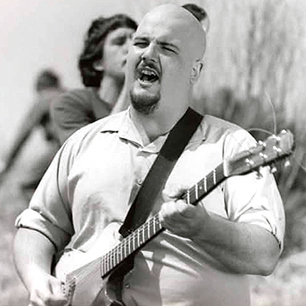D. Boon’s name has survived as one of the greatest punk guitarists despite his band, the Minutemen, only being active for five years prior to his untimely death. They were political revolutionaries, encapsulating the core ethic of punk and alternative rock but never being bound by a particular style. It’s the numerous elements that guitarist and vocalist D. Boon incorporates into his playing that really sets him apart, building elements of free jazz, folk and funk into their California punk sound. D. Boon breaks down the walls between genres like no other punk player, yet he’s often overlooked because of the Minutemen’s firmly cult status.
Bio
Dennes Boon was in 1958 in San Pedro, California, meeting future band-mate Mike Watt at an early age. The two grew up together, with Boon soon taking up the guitar and Watt picking up the bass. They were influenced by bands like the Who when they first got started, but they soon became immersed in the sounds of punk acts like Richard Hell and the Voidoids and the Germs. After enlisting the help of another friend on drums, the trio took off to play the Sunset Strip circuit in LA before signing to Black Flag’s label.
Notable Recordings
The Minutemen recorded several full-length albums, but the double album “Double Nickels on the Dime” receives the most critical acclaim, featuring songs such as “Corona,” “#1 Hit Song,” “History Lesson Part 2” and “It’s Expected I’m Gone.” The length of the album gave Boon and the Minutemen the chance to explore more musical avenues, leading to the inclusion of tracks like the endearing, impressive and folk-inspired “Cohesion.”
Techniques
The first thing you’ll notice about D. Boon’s guitar playing is that he rarely uses distortion at all. This seems like a contradiction in terms, as if no punk could exist without distortion, but D. Boon proves that the attitude and inventive playing is more important than the effects applied to the signal. He also focused on the treble end of the EQ, if you’re looking to completely replicate his sound.
Other than the lack of distortion, the thing that sets Boon apart is the jazz, blues and funk elements he brings in to his playing. It’s testament to the fact that regardless of the genre you play in, a background in different styles can be invaluable. Listen the solo to “It’s Expected I’m Gone,” with its raw, bluesy expressionism and powerful use of string bending. Bending strings is simple, just play a note and push the string forcefully upwards as it’s ringing out. Practice hitting specific tones (you can play the note one or two frets higher and try to match it) and you’ll be able to bring some musicality into your solos.
This might all make Boon seem like a daunting guitarist to emulate, but the punk-friendly, straightforward approach still finds its way through into his playing. Listen to “#1 Hit Song” – it’s built from just three chords, with the main riff being a back and forth between A7 and D9. These aren’t chords you’ll encounter much in punk (again, showing his musical experimentation), but in practice the song is as simple to play as any other punk song.
Overall
D. Boon makes the ideal end to this series because his style of punk opens the door to other genres and some creative experimentation. One of the best things you could do with your playing is take a cue from Boon and not feel constrained by the conventions of the genre. Punk is constantly evolving, and it takes an innovative player like Boon to forge new paths in music.
